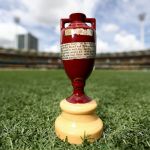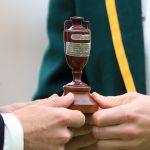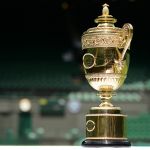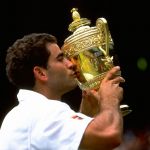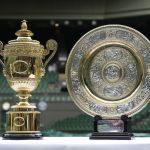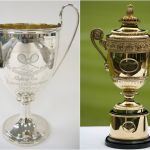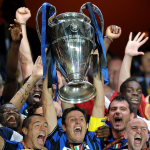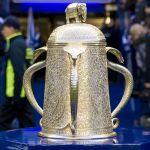
Cups stories
The genesis and quality of the most epic symbol of sport
April 24th, 2020
Raising a cup represents the most glorious moment in any sport. Whether it's Cannavaro in Berlin, Michael Jordan on the United Center parquet or Roger Federer on the Wimbledon turf, the time of delivery of the trophy always has an epic aftertaste, as if it actually entered history in the moment in which you touch the prize. All the cups tell a story, made by great craftsmen and misadventures, from particular designs to disproportionate dimensions, made by men who made iconic competitions through symbols.
FIFA WORLD CUP
It is the dream of every soccer player, since he was a child: to represent his own country and raise the World Cup. For example, Diego Armando Maradona said it when he was just over 10 years old in Pipo Mancera, for all Argentines "Señor Televisión". "Mis sueños son dos: mi primer sueño es jugar en el mundialy el segundo es salir campeón" tells a scalp child to those who practically invented truth-TV in Argentina.
That cup has an Italian aftertaste. It was introduced in 1971 and was conceived by the Italian goldsmith and sculptor Silvio Gazzaniga, produced by the Bertoni Srl company in Novate in the province of Milan. The master designed the Europa League cup, that of the European Super Cup, the cups for the baseball, bobsleigh, volleyball and medals for the basketball world cup. But the most important cup remains the one that was chosen among the 53 works that participated in the first competition. The meaning is reported by Gazzaniga himself: it represents the athlete's joy and greatness in the moment of victory, with two stylized athletes who rejoice while holding up the world, the one they govern from a footballing point of view, brandishing that trophy. 36.8 cm high with a base diameter of 13 cm, the cup weighs 6175 g and is in solid 18-karat gold. One of the most particular aspects of the cup is the deadline: it will be exactly like that until 2038, then in all probability it will be renewed.
WIMBLEDON - THE GENTLEMEN'S SINGLES TROPHY
The story behind the trophy given to the winner of the Wimbledon men's singles tournament is as absurd as the rigid traditions and iron laws of the All England Lawn Tennis and Croquet Club. The first trophy is dated 1887, replacing the previous Field Cup and the Challenge Cup, both won by William Renshaw. The All England Club took great care of the economic aspect and spending 100 guineas (British currency from 1663 to 1817) every year to buy a third trophy was considered excessive. From then on, it was decided that the new trophy would never become the property of the winner. The champions still receive a 3/4 replica of the trophy.
The award is in gilded silver, the trophy is 45.7 cm high with a diameter of 19 cm. There is an inscription that reads "The All England Lawn Tennis Club Single Handed Championship of the World" accompanied by the name of all the champions who raised it on the most cured grass in the world by the most precise gardeners in the world. In 2009, the space needed to enter the names ended and a base was added on which to continue to engrave (rigorously by hand by the Polish Roman Zoltowski in 18 minutes) the names of the winners. The most extravagant thing is the pineapple placed on the top of the cup. There is no single explanation for a detail that does not go unnoticed. Two versions are more accredited: the first has to do with a tradition of the British Navy captains, who used to put a pineapple on the top of their gates to symbolize the presence at home and not at sea; the second concerns the status quo that pineapple represented in the seventeenth century, a food that was practically unobtainable that symbolized wealth.
GIRO D'ITALIA - TROFEO SENZA FINE
The Giro d'Italia is one of the most compelling events when it comes to cycling, a sport that does not just reward the winner of a round, but that has many other prizes to be awarded stage after stage. They can be delivered in the form of a shirt - which changes color depending on the prize and the lap - but the real final prize is the "Trofeo senza fine" ("Endless Trophy"). Since 1999, the prize has been awarded to the winner, consisting of a curved, spiral-bent copper bar, which rises from the base in ever wider circles, on which the names of all the winners are engraved. The spiral almost never seems to end and hence the characteristic of the name.
UEFA CHAMPIONS LEAGUE TROPHY
"It may not be an artistic masterpiece, but everyone in football wants to get their hands on it." The trophy raised by the best teams in Europe is the most coveted object, according to some even more than the World Cup. The current 73.5 cm and 7.5 kg version is delivered and donated by UEFA only after the victory of 5 European titles, as established by the 1968/69 standard - then changed in 2008/09, with the original trophy that has not moved since headquarters. Real Madrid, Ajax, Bayern München, Milan, Liverpool and Barcelona are therefore lucky enough to have an authentic cup in their museums. The other winners have, as in other cases, a replica.
What we see today is not the initial project, but the fifth re-edition of the cup. Jürg Stadelmann, a well-known jeweler from Bern, was commissioned to build it in 1967, after UEFA gave the cup won to Milan. Jürg Stadelmann recalls the first meeting with Herr Bangerter, then general secretary, who practically commissioned him a puzzle: "My father Hans and I went together to Herr Bangerter's office and covered the whole floor with drawings. The comments they were 'The Bulgarians would like the fund' or 'the Spaniards would like this detail' and again 'but the Italians would prefer it this way' and went on with all the nations". The shape of the handles earned him the nickname "big ears" in multiple languages, including French ("la Coupe aux grandes oreilles"), Spanish ("La Orejona") and Chinese ("大 耳朵 杯").
NBA - THE LARRY O'BREIN TROPHY
Perhaps the most underrated sports trophy of all, especially in terms of importance and probably because it was delivered into the hands of the owner of the franchise that wins the NBA Playoffs and not directly into the hands of the players - who by far like the celebratory ring. The award was created in 1977 and the first to win it were Bobby Gross, Bill Walton and Maurice Lucas' Portland Trail Blazers. It replaced the Walter A. Brown Trophy and only in 1984 took its current name, in honor of commissioner Larry O'Brien.
The 61 cm high and 6.57 kg weight trophy is a mix of 24 carat gold, Sterling silver and vermeil. The shape clearly resembles a ball that enters a basket and its value is around $ 13,500. The production of the replica delivered to the winning team is entrusted to the Tiffany & Co. Silver Shop.
THE ASHES URN
Many of the sports that are known today and that have become religions over the years were born in England. Football is only the tip of the iceberg, but 5 centuries before "the english game" cricket was invented. Cricket is in fact the second national sport, behind football and just before rugby. Being in all respects an ancient sport, it preserves traditions that have centuries-old roots. Among these is "The Ashes", which is the oldest international cricket competition in history. The first edition dates back to 1882 and has since been postponed only because of the two world wars. With the formula of the Test Tricket, the English and Australian national teams compete to bring home a bizarre trophy.
The winner is given "The Ashes Urn". The trophy consists of a terracotta urn of 10.5 cm which symbolically contains the ashes of the team that comes out defeated by the challenges. Considering the 335 challenges - counting also the test matches - Australia has won 136 times, while England 108; 91 instead the times when it ended in a draw.
PARIGI-ROUBAIX - CUBE OF PAVÉ
When you think of cycling, you immediately think of the classics, which is the most important one-day in-line races of the UCI World Tour. And when you think of the classics, it is practically impossible not to mention the Paris-Roubaix, the Queen of the classics or the Easter Race considering the period in which it is held (the second Sunday in April). The route varies depending on the edition, but the distance to be covered is never less than 250 km.
There is nothing classic, however, in the prize that the cyclist who crosses the finish line receives. At the end of the grueling race you receive a cube of pavé - a symbol of the mantle on which the runners compete - weighing 15 kilograms. The story behind this award has never been explained very clearly, but it seems that the award that cyclists received at the beginning of the twentieth century was something "insignificant". Years later, one of the winners raised the question and decided on the symbolic cube, as if delivering a piece of racing history.
CONMEBOL COPA LIBERTADORES TROPHY
The most felt and one of the heaviest trophies. Copa Libertadores weighs 10.25 kg and is exactly 99 cm tall. It was conceived in 1959 by an Italian immigrant, Alberto de Gásperi - with an accent because he now felt to all intents and purposes a Peruvian citizen. His "Joyería Camusso" in Lima is still considered a place of worship for South American football.
The upper part of the cup is made of sterling silver, excluding the player represented above and made of silver coated bronze. The pedestal is certainly the most discussed part: built in plywood, it was designed to contain only 18 plaques with the names of the winners. After several decades, the pedestal continues to grow and expand. Just like the Champions League, only after a certain number of wins did the cup become club property. The first teams to do this were Estudiantes and Indipendiente.
STANLEY CUP
Ice hockey is a religion in certain countries, especially the colder ones. The Stanley Cup represents the Holy Grail, the trophy to be raised if you want to enter history. National Hockey league (NHL) winners can raise the cup 89.54 cm for the beauty of 15.5 kg. It is also one of the most "unfortunate" cups considering the number of misadventures he has experienced.
Since the time when the cup keeper Walter Neubrand was forced to leave it in the cargo area of Vancouver airport for weight limits from the time when Edmonton Oilers' Mark Messier took it to a strip-tease club in his city of origin and allowed the fans to drink from the cup, causing showy dents.
CALCUTTA CUP
The genesis of the competition is similar to that of the Ashes Series, translated from cricket to rugby at 15. The trophy is awarded to the winner of a match between England and Scotland, two super powers of international rugby. The name derives from the memory of the Indian rugby club of Calcutta dissolved in 1878. The challenge has been on stage since 1879 and England is 71-40 ahead of the Scottish cousins, while 16 were the draws.
From an aesthetic point of view, the cup is one of the most beautiful in circulation. 45 cm high, the trophy has three cobra-shaped handles and a white elephant to surmount the top. A dedication was engraved on the wooden base of the cup: "The Calcutta Cup, offered to the Rugby Football Union by the Calcutta Football Club as an international trophy to be contested annually between England and Scotland - 1878".






















